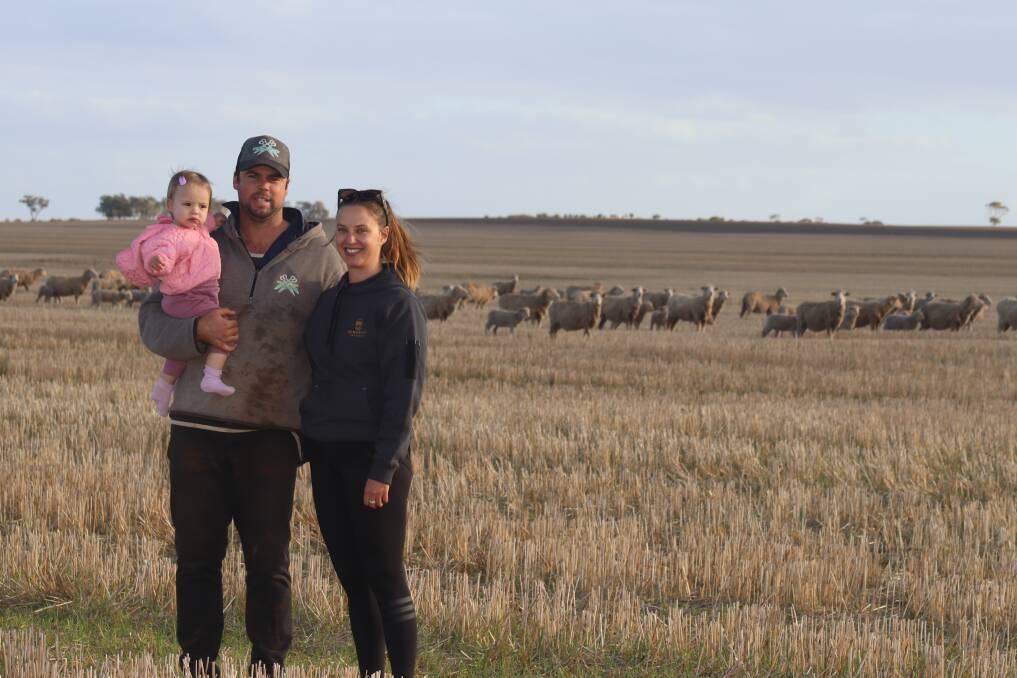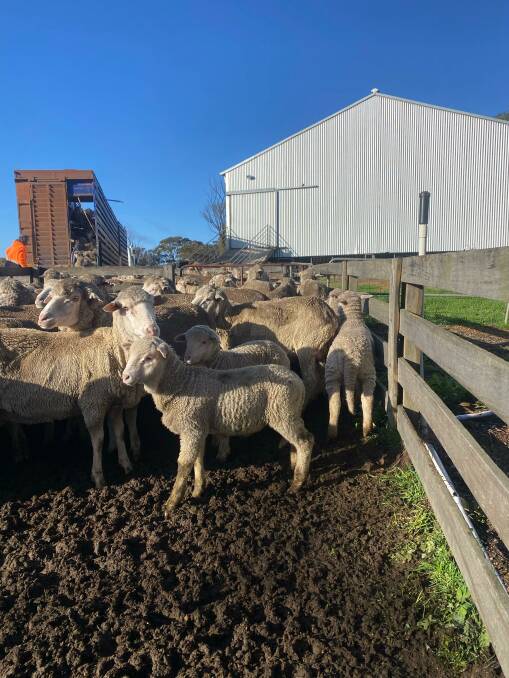
Kukerin father-and-son duo, Graeme and Ryan Taylor are keeping the family farming legacy alive at their property, Homebush, and are more passionate about producing dual-purpose Merinos than ever before.
The equal part grain and stock business is spread over four properties consisting of 5260 hectares of owned and leased land from Kukerin to Pingrup and is run by the pair - with help from Ryan's mother Tracy Taylor, his fiance Victoria Denn and daughter Ella, along with full-time stockman Leo Kelly.
When Ryan returned to the farm 10 years ago, the family was running only 500 Merino ewes, which has now significantly increased.
Fast forward to 2023, the Taylors maintain a higher stocking rate and have improved their farming practices to now run 5500 sheep, comprising 4500 Merino breeding ewes, 900 hoggets and 100 rams.
"Having more Merinos and a self-replacing flock has definitely made a positive improvement on how we operate," Ryan Taylor said.
The family loves the breed's dual-purpose ability and use it to their advantage, focusing on meat and wool characteristics.
To assist in maximising yield and production, they join half of their Merino ewes to Merino sires for wool purposes and the remainder to White Suffolk rams to focus on meat production.

Visual appraisal is the method of choice when selecting rams, although Ryan said they have looked at eye muscle figures when selecting their Merino rams from the East Mundalla stud, Tarin Rock.
The Taylors have also been purchasing their White Suffolk rams from the Ditchburn family's Golden Hill stud, North Kukerin, for quite some time.
"Ideally, in any Merino rams we purchase, as long as they have nice wool, a straight back and correct feet, we are happy," Mr Taylor said.
He said last year, they purchased 100 Merino stud ewes from the Golden Hill stud in an attempt to start breeding their own Merino sires.
"The first lambs have just dropped so we are excited to see how they go," Graeme Taylor said.
A nine-week joining period beginning on November 1 each year provides easier management for the Taylors, with rams going in with the ewes before harvest and taken out after Christmas.
"We join them at 2pc with the ewes and try to allocate two properties to Merinos and the other two for the prime lamb breeding program," Mr Taylor said.
Due to a clash with shearing, and maintaining good conception rates in recent years, pregnancy scanning is only carried out every two to three years.
Six weeks prior to lambing, the ewes will be vaccinated with Eryvac to control and prevent Erysipelas arthritis.

Following the strong conception rates, the Taylors have seen their lambing percentage settle at 94pc (for ewes joined) for the past four years when lambs begin to drop in early April.
At lamb marking, lambs are also vaccinated with Eryvac, along with Glanvac 3in1 for cheesy gland, tetanus and pulpy kidney, Scabigard, a fly Clik to prevent flystrike and the use of pain relief.
August is jam-packed with both weaning and crutching.
After both the Merino and prime lambs are weaned, the majority of the prime lambs and wethers are sold to V&V Walsh, Bunbury, or WAMMCO International, Katanning.
"All of the wethers, bar 120 of them, are sold before Christmas, we have always aimed to sell them by then," Mr Taylor said.
"They are finished on vetch pastures and sold at about eight to nine months old, at a dressed weight of about 25 kilograms.
"After weaning, the ewes are classed accordingly, based on wool and carcase quality.
"We retain the majority of the ewes - apart from about 15 or 20 that will most likely be sold at the Katanning saleyards."
The ewe hoggets are classed again, when they are one to one-and-a-half years old, to determine what will be joined with Merino rams and what will go to the White Suffolk sires.
Mr Taylor said they had recently acquired the experience of Elders stud stock representative and classer Kevin Broad to assist with ewe classing.
"At the end of the day, we ideally want to keep something that has a big frame, good meat characteristics and has the ability to cut a good amount of wool," Mr Taylor said.
The main shearing at Homebush is scheduled for February every year.
But there is an exception with Merino lambs shorn in mid-October, along with any leftover prime lambs that are still on-property.
"The prime lambs aren't shorn before they are sold, as a rule," Mr Taylor said.
"But if there are some left over, we will shear them with the Merino lambs.
"After the lambs are shorn, they are put out into a paddock for two weeks before being put into the feedlot at 45-50kg and supplementary fed lupins and barley.
"Lupins, barley and hay are also the supplement of choice to feed the ewes during joining and lambing - once a week.
When it comes to pasture management, the Taylors like to cover all bases, including the lighter, medium and heavy country at Homebush.
"We sow a lot of clover," Mr Taylor said.
"We use serradella on the lighter country, sub-clovers on the medium country and medics on the heavy country.
"Alternatively, any paddocks that need a rest from pasture or crops are sown with vetch."
The cropping program covers 3450ha throughout the four properties, with barley being the main source of feed and crop income.
"We sow 2200ha of barley, 600ha of wheat, 200ha of oats and 450ha of various pasture mixes," Mr Taylor said.
Along with working on the farm together, Ryan and Graeme are also heavily involved in the industry off-farm, with Ryan doing mulesing and Graeme being the local Elders livestock agent.
Ryan has grown his clientele since he began crutching three years ago, while Graeme has been servicing clients from Dumbleyung to Lake King for 20 years.
For three months of the year, after seeding, Ryan does his annual mulesing run where he aims to mules from 40,000 to 50,000 lambs.

